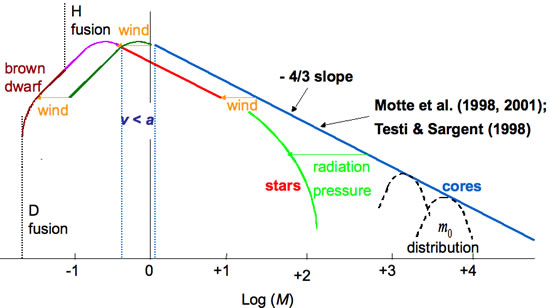研究成果藝廊 > 理論天文物理理論天文物理
(Theory)
研究成果藝廊
理論天文物理理論天文物理
(Theory)
| Magnetization-Shaped Initial Mass Function |
|
圖片來源: Shu, Li, and Allen

Schematic Initial Mass Function (Shu, Li, & Allen, 2004, ApJ, 601, 930)
|
| The MN(M) distribution, mass of star formed during any fixed interval of time, is plotted against stellar mass (in unit of solar masses) in log-log format. The convolution of a bell distribution with a -4/3 power-law distribution of v^4/G^(3/2)B0 produces the solid curve labeled by "core". This distribution reaches a natural peak when v equals the thermal sound speed a, which itself has a range of values indicated schematically by the two vertical dashed lines. A further extension toward "subthermal values" (beyond that expected from the distribution of m0) may result if fragmentation of thermal cores can occur during the subsequent collapse, or if binary disruption occurs to unbind substellar companions from normal stars. Without fragmentation or binary disruption, the core mass is reduced to the star mass by the arrows depicting the effects of YSO winds and radiation pressure acting on dust grains during the gravitational collapse of any core. The hydrogen- and deuterium-burning limits that separate stars from brown dwarfs and brown dwarfs from (free-floating) planets are indicated. No discontinuity at the H-burning limit occurs because pre-main-sequence stars are observed to lie in the Hertzsprung-Russell diagram above the line (zero-age main sequence) where they would start burning hydrogen; thus, hydrogen burning could not have played a role in the determination of their initial masses. On the other hand, T Tauri stars do exhibit a "birthline" (Stahler 1983), which has been associated with deuterium burning, and deuterium burning could play a role in the shape of the lower mass end of the stellar IMF (Shu & Terebey 1984). |
 asiaa.sinica.edu.tw 媒體連絡: epo
asiaa.sinica.edu.tw 媒體連絡: epo asiaa.sinica.edu.tw
asiaa.sinica.edu.tw